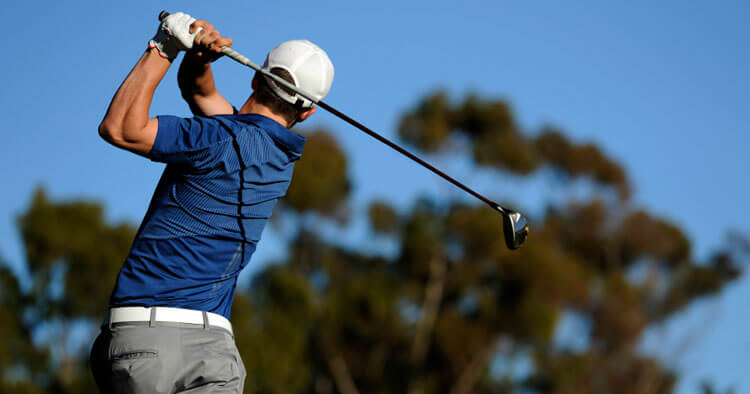Overuse Injuries Are The Most Common Golf Injuries
Despite golf injuries being of relatively low incidence, if you are an avid player, you may well suffer from a golf related injury at some point during your playing career. The majority of golf injuries are overuse injuries, meaning the are injuries resulting from the repetitive action of the golf swing more so than a traumatic incident. Clearly this makes perfect sense given golf is a non contact, low impact sport that overuse injuries in golf a far more common than traumatic injuries. Repetitive swinging of the club can place load on a number of tissues/joints in the body, the two most common golf injuries will be briefly discussed below.
Golf And Back Pain
Back pain is the most common of golf injuries. It isn’t difficult to see why back pain is so prevalent among golfers, when considering the keen golfer may spend hours upon hours each week in a mildly stooped stance hovering above a ball whilst twisting at speeds of up to 200kph. The combined flexion and rotational stresses of the swing place considerable pressure on the spine and the back pain experienced by golfers can frequently be related to a number of tissues/conditions:
- Soft tissues, including muscle strains from over twisting trying to hit the ball to hard
- Lumbar discs strains from poor spinal curve control, adopting flexed and twisted lower back postures when swinging a club
- Sacroiliac joints
- Spinal joints (facet joints)
- Stress fractures
- Arthritis
Don’t discount the mid back or neck as a source of pain in golfers too. The golf swing action places strain on these areas of the spine also, an effective swing requires good thoracic spine rotation and a lack of mobility in the mid back can lead to thoracic spine pain if players try to swing to hard and “over rotate” an inflexible spine.
- If your core muscles are weak,
- you have underlying trunk, or hip stiffness
- or you have poor postural control, technique through any phase of your swing
any of these things in unison may put you at risk of developing back pain, a combination of the above and you may be a ticking time bomb with regard to developing golf related spinal pain. Often such pain will only present around a significant increase in golfing load This may present in the form of a golf weekend away, club tournament, summer holidays… situations where multiple rounds are played in a short space in time, leading to a substantial increase in playing time and swing volume compared to the day to day standard.
Golf And Elbow Pain
The elbow is the next most common location for golf injuries. Elbow injuries from golf can occur as a result of abnormal ground impact during the swing, or due to the grip on the golf club, even result from pulling the trolley full of clubs. Excessive gripping, poor swing technique, ground impact, dramatic swing volume changes can all lead to the onset of
“golfers elbow” and
“tennis elbow” complaints. Tendinopathy is the most common golfing condition affecting the elbow. Frequently referred to as “golfers elbow” or “tennis elbow” these names related to tendon complaints felt on the inside and outside of the elbow respectively.
Ironically “tennis elbow” is more common among golfers than “golfers elbow”. However the same can be said for the general population where “tennis elbow” is a more prevalent condition. With these tendinopathies the pain experienced may be most significant at the top of the backswing and/or at impact with the ball.
- The risk of golfers developing tendinopathy increases with age, with golfer’s elbow and tennis elbow complaints being less common in the younger golfing population compared to the middle aged golf enthusiast.
The good news is tendinopathy readily resolves with appropriate management. Treatment typically requires a component of rest, coupled with physiotherapy treatment to help promote healing and return to play. Improving any improper swing/grip mechanics is often beneficial and the use of a golf pro and some more lessons can be of use here once able to hold and swing a club again.
Tendinopathy generally arises where overuse of the tendons is involved… so be sure to rotate your practice regimen when possible, allowing your forearm muscles and body to get adequate rest.
Tips To Consider When Managing Elbow Tendinopathy In Golf:
- Ideally practice on real turf rather than rubber mats, rubber mats and the underlying concrete can be unforgiving on impact.
- Tennis elbow supports may be of use to help manage the pain. Off loading, counter force braces are cheap and have some research to suggest they can be of good use in managing elbow pain like tennis elbow.
- Try to avoid impact with tree roots / rocks… on ball contact during your swing. If you are recovering from a tennis or golfers elbow complaint and have a bay lie then consider moving the ball to a safe spot where impact with something other than the ball can be avoided.
- This can be taken a step further in a return to play by considering teeing-up the ball on fairway shots to avoid excessive ground contact.
Disclaimer: Sydney Physio Clinic provides this information as an educational service and is not intended to serve as medical advice. Anyone seeking specific advice or assistance on What Are The Most Common Golf Injuries? should consult his or her physiotherapist, GP or otherwise appropriately skilled practitioner.


